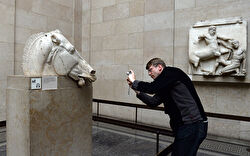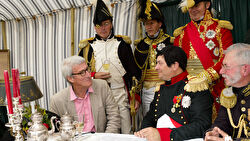
In H Rider Haggard’s late-Victorian adventure yarn She, two Englishmen set off for darkest Africa to discover the origins of a legend. Intrepid chaps in Norfolk jackets, they carry conventional prejudices about the dangers of polluting the blood by intermarriage between races. That is until they fall among a cave-dwelling tribe ruled over by “She-who-must-be-obeyed”, the queen Ayesha:
“Though the face before me was that of a young woman of certainly not more than 30 years, in perfect health, and the first flush of ripened beauty, yet it had stamped upon it a look of unutterable experience, and of deep acquaintance with grief and passion… and it seemed to say: 'Behold me, lovely as no woman was or is, undying and half-divine; memory haunts me from age to age, and passion leads me by the hand – evil have I done… and sorrow shall I know till my redemption comes.’”
It is enough to burst the buttons on a Victorian gentleman’s waistcoat. Being an Englishman, though, our hero soon snaps out of it, escapes the danger of sexual subjugation, and by the end of this tremendous adventure fantasy has returned to England, where women knew their place.
The departure of young men from Britain to try their luck in the expanding empire had two consequences. Firstly, it drained the pool of available marriage prospects for the young women left behind. And secondly, it raised the challenge of where the young men were to find an outlet for their sexual and romantic needs. In the early days in India, they seem to have made their own arrangements, often on a commercial or semi-commercial basis.
“I now commenced a regular course of f------ with native women,” writes Edward Sellon in one of the rare accounts of sexual relations in the early days of the Raj. In his memoirs he paints a picture of available young Indian women who “understood in perfection all the arts and wiles of love”.
Sellon reported that most important temples had troupes of dancing girls attached to them, whose job it was to sing and perform “Nautch” dances, and “to prostitute themselves in the courts to all comers, and thus raise funds for the enrichment of the place of worship to which they belong”.
He knew of cases where “Nautch girls” had been paid 200 rupees for a single night’s company, which was “not very much to be wondered at, as they comprise some of the loveliest women in the world”.
Elsewhere, he recalled two classes of prostitutes: one charging two rupees for her services, the other, an infinitely superior creature, five. The “fivers” were “the handsomest Mohammedan girls”, and in his long experience of “English, French, German and Polish women of all grades of society” he had never found one to compare with these “salacious, succulent houris”.
They did not drink, they were scrupulously clean, shaved their pudenda, dressed sumptuously, wore flowers in their hair, played musical instruments and sang sweetly.
There was no suggestion from Sellon that women might have been driven to sell themselves by anything as odious as poverty or misfortune. They fulfilled the male fantasy of being happy hookers. India, he preached, was a place where more or less any sexual service was available, free of shame, if not free of charge.
In India young Britons gawped in astonishment at the decorations on the walls of some Hindu temples, with their depictions of intercourse in all sorts of positions not normally encountered in the rectories of Hampshire. (Sadly, the story of the supposed origin of the missionary position, as the only arrangement which British missionaries believed suitable for the beastly business, is probably untrue.)
After being posted to India in 1842 the great orientalist Richard Burton set about investigating the sexual possibilities with the dedication which later characterised his attempts to find the source of the Nile.
He became convinced that women in tropical countries were more passionate than men, reported the belief that if a man gave a woman seven large cloves to eat on the 17th of the month she became insatiable, noted the prevalence of lesbianism in Muslim harems, developed a connoisseur’s eye for Nautch girls, and recorded that British objections to the well-established custom of beheading unfaithful wives had merely created a glut of semi-professionals, so that “if a young officer sent to the bazaar for a girl, half a dozen would troop to his quarters”.
Sexual relations were quite as exploitative as the East India Company’s other relations with India. But significant numbers of early British visitors made more permanent arrangements and took Indian wives and mistresses, who seem to have occupied a recognised position in society.
Although later politicians and officials claimed to be scandalised when missionaries reported that miscegenation was occurring, it would have been more astonishing if men possessed of the energy to leave Britain and seek their fortune overseas were not also keen to satisfy more immediate physical and emotional needs.
There is ample evidence of easy social relations in the early stages of the British presence in India. Johan Zoffany’s 1780s Lucknow painting Colonel Mordaunt’s Cock Match shows the notoriously louche nawab of Oudh enjoying himself among English officers. Colonel James Skinner, founder of the Indian cavalry regiment Skinner’s Horse, was the son of a Scottish officer and his Rajput mistress (though this was denied by many of his family). Eighty children claimed him as their father. One of the great spectacles of early 19th-century Delhi was the sight of the East India Company resident, Sir David Ochterlony, taking the evening air by riding an elephant around the Red Fort, followed by his 13 Indian wives, each mounted on her own elephant.
By 1820, the Company had decided it was better to warn new arrivals against the “insinuating manners and fascinating beauty” of Eurasian girls, for fear of making “a matrimonial connection which he might all his lifetime regret”. But, like almost all efforts at prohibition of pleasure, the decree was doomed to failure. The “bibi”, or mistress, was simply a fact of life.
However the uprising in 1857 – and the answering brutality of the British – left a long legacy of bitterness and mistrust between the two cultures. From now on, the races would maintain some distance. The decision that henceforth India would be run not by the East India Company but by the British government meant greater involvement by elected politicians, and required administration on a much more formal basis.
Soon there was no need for soldiers, officials and traders to keep a mistress in the bibi house. They could live, instead, a tropical replica of life in England, an existence which did not so much embrace India as defy it.
The laying of railway tracks meant that European wives in India could be packed off to the hill stations in hot weather or, once the Suez Canal had opened, could perhaps be sent home to England for sickness or childbirth. Even those men who had arrived in the country as bachelors had only to wait for the start of the longed-for cold season and the arrival of what became known as the Fishing Fleet – young women from the home country out to net themselves a husband from among the single men serving in India.
As one 20th-century official recalled, the racial discrimination was quite blatant. “In the hot weather you took out what was called the 'B’ class girl, usually Anglo-Indians, who were dears in every way and the greatest fun. But the moment the cold weather started they were taboo, because all the young girls from Roedean, Cheltenham and the great schools of Britain came out in the P&O liners and you were expected to toe the line.”
Throughout the cold season – of which Christmas was the high point – the young men and women circled each other at parties, dances and sports events, sizing up who might make a decent marriage partner. Women who failed to find anyone suitable went back to England, nicknamed “returned empties”.
The presence in India of what came to be known as “memsahibs” (a corruption of “ma’am” and “sahib”) changed everything.
In the 1830s a magistrate in India had written home that he had “observed that those who have lived with a native woman for any length of time never marry a European… so amusingly playful, so anxious to oblige and please, that a person after being accustomed to their society shrinks from the idea of encountering the whims or yielding to the fancies of an Englishwoman”.
He would not have dared to write like that 50 years later: let the Englishwoman loose in India and she fought her corner. Later generations have endowed the memsahibs with an unappealing reputation, as superficial snobs and irredeemable racists who ended an era of happy coexistence. But, they must have been a varied bunch.
There were plenty who never bothered to go beyond learning “Kitchen Hindustani” in order to shout instructions at servants. But there were others who developed a genuine affection for the country, founded orphanages, taught in schools and sacrificed their own health to improve the health of Indians.
Women confident enough to reject the role assigned to them by men could sometimes become forceful enemies of the very masculine business of imperialism. Like the Victorian socialist Annie Besant, they could find the colourful abundance of Indian spiritualism an intoxicating alternative: when she moved to India in 1893, Besant took to wearing Hindu mourning dress in grief at what the British had done to the country, and spent decades encouraging Indians to throw off colonial rule.
Subversive figures like these were, of course, hugely outnumbered by the conventional memsahibs, exerting what they considered a civilising influence in the military cantonments, towns, cities and hill stations. How many younger officers wanted to cohabit with an Indian woman when the colonel’s wife so clearly disapproved? Indian sexual gymnastics were no match for raised British eyebrows.
Hanky-panky was most likely to occur within the British community: a man who dispatched his wife to the comparative comfort of a hill station while he continued to work on the plains during the hot season had to be utterly confident he could trust her.
A woman’s position in colonial India was not particularly easy. The heat, the humidity, monsoon rains and the swirling clouds of dust could destroy an English rose in the space of a year or two.
To the restrictions imposed by the role ascribed by the men of empire were added the daily chores of trying to keep clothes clean, stopping meat putrefying and seeing that there was enough water for a rudimentary bath at the end of the day, all of it amid relentless heat, homesickness, often absent husbands, interminable railway journeys, the fear of tropical sickness striking a child (later often replaced by that numb, never cauterised wound, when they were sent off to boarding school at the age of seven), the temptations posed by single men and the menace of flirtatious other wives.
And all to be endured in the foul smell that a capricious wind might waft around at any time from the thunder box at the back of the bungalow.
Across much of the rest of the empire, informal relationships between lonely young men and local women became commonplace. In Sarawak and Malaya the practice was either recognised or encouraged: the “sleeping dictionary” being an established way of learning the local language.
But when power was distributed so unequally, it was dangerous: how could a magistrate dispense justice fairly when he might be sharing his bed with a relative of one of the aggrieved parties?
In typically British fashion, these things were not noticed, as long as no one drew attention to them. But in 1908 the case of Hubert Silberrad, an assistant district commissioner in the Nyeri district of Kenya, blew the arrangement open.
Silberrad had bought two Kenyan girls (for 40 goats apiece) from a colleague who had been promoted. One of them, aged 12, was reluctant to be passed on, the other agreed to the arrangement in exchange for a monthly wage.
When, three years later, Silberrad attempted to acquire a third mistress and one of his own policemen objected, Silberrad locked him up for the night, on grounds of insubordination.
Two white neighbours, a Mr and Mrs Scoresby Routledge, came to express their outrage and then Mr Routledge rode four days through the rain to complain to the Governor in Nairobi. The Governor ordered a private investigation, which concluded that Silberrad had brought the administration into disrepute by “poaching”.
Silberrad lost a year’s seniority and the Governor issued a circular to his officials, warning that, “morals apart”, such practices were “in every way detrimental to the interests of good government”.
The punishment testifies to the distinct priorities of colonial administrators. But what outraged the Routledges was less the rights of Kenyans than the wellbeing of empire.
Mr Routledge refused to let the matter rest and wrote a letter to The Times claiming that “the interests of this country [are] suffering from the demoralisation of native women by British officials”.
A debate in parliament followed, which in turn obliged the Colonial Secretary, Lord Crewe, to issue what became known as the “Concubine Circular” in January 1909. Formally, the document had no name, although the file for comments and replies was entitled “Immoral Relations with Native Women”. Taking native mistresses was “injurious and dangerous” and “disgrace and ruin” awaited those who made the mistake of entering into “arrangements of concubinage with girls or women belonging to the native populations”.
So what were girls to be told about their contribution to the empire? “Britain has been made by her great men,” wrote Agnes Baden-Powell and her brother in The Handbook for Girl Guides, or How Girls Can Help Build up the Empire, “and these great men were made great by their mothers.”
Settling in a colony could offer many “delightful prospects”, such as “turning packing-cases into furniture” and “producing capital meals with three bricks and a baking pot”. The thing to remember was that “To a true-hearted girl who wishes to make a man happy, there is bliss in an African hut.”
Article courtesy of The Daily Telegraph. Original found here.


